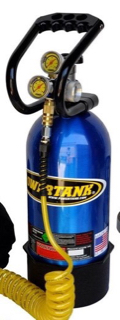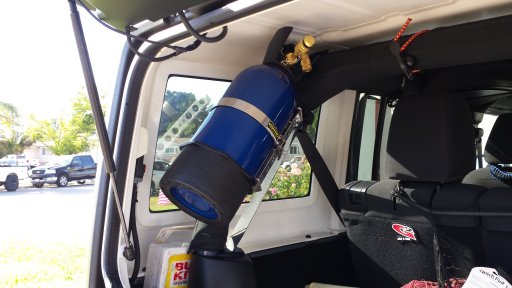
Benefactor
There area variety of reasons to upgrade to an OBA (On Board Air) setup in your rig. Maybe you've purchased bigger tires and the little $30 compressor from the auto parts store won't cut it any more. There's the option of running air tools, though that may also require an air tank.
You're options are basically a CO2 setup or an air compressor. Each has their pros and cons. It's up to you to ultimately decide what will work best, based on your needs.
CO2
CO2 is liquefied carbon-dioxide, typically stored in a 10# or 20# tank. Power Tank is the standout (and most $$$) manufacturer of tanks and accessories. Their yellow powder coated tanks are well known, and seen among the 4WD community.
These tanks need to be stored upright and hard mounted inside your rig. For ease of access to the tank for refilling, there is usually a metal strap that unlatches and the tank can be pulled out. This must be accounted for when picking a mounting location. For example, my CO2 tank is only 4" away from the ARB fridge. Without the fridge slide, there would not be enough room to fully open the latch straps and then remove the tank.
When it comes to filling tires, the speed at which CO2 performs this task is second to none. It's extremely fast, and can produce a large volume at the same time. This is important if you want to re-seat the bead of a tire. Using a large ratchet strap around the tread of the tire will direct the expansion to the sidewall, and seat the bead easier/faster. This is true if you're using CO2 or a compressor.
When using a CO2 tank, you never have to worry about the noise level. The only sound you hear is the slight wooshing inside the tire as it's being filled.
A CO2 setup can be setup can be put together fairly inexpensively, but you'll have to shop for the individual parts. The Power Tank option can be as much as a really good compressor. CO2, no matter how big of a tank you have, is a limited resource. When you're out, you're out. Unheard leaks can ruin your fun when you go to air up at the end of a trail and find an empty tank. Or to run that air tools for a trail fix. Cheap regulators can freeze over and cheap hoses can splinter if frozen for too long.
Refills can be a big deciding factor. Check for availability in your area for this service before buying equipment. It's illegal to fill CO2 tanks within San Francisco. I have a friend who welds and I'll drop my tank off with him to get refilled in the East Bay. You'll have to find a shop that will preferably return your same tank. Some only do a tank swap of what they have in the back room. A 20# tank costs me about $25.
The number of times you can refill your tires will depend on the size of the tire, and pressure ranges (say 15PSI up to 40PSI). The only way to determine how much CO2 you have left is by weight, and maybe shaking to feel for the level of the liquid. A pressure gauge for the tank (not what is coming out) will show full pressure until the tank is empty.
Lastly, CO2 is soluble with the rubber compound found in tires. It permeates through the material and escapes into the atmosphere, thus reducing the tire pressure over time. If you wheel often enough, you can keep this in check due to the constant refilling of tires, and checking the levels. But if you only go out every couple of months, you should periodically check your pressure levels, and consider refilling with air at a gas station.
Air Compressors
These can range from a cheapo unit that can barely fill a passenger tire up to something that can run air tools without missing a beat. There are a few notable companies out there making well thought out and put together compressors; Viair, ARB, Extreme Outback to name a few.
Your typical air compressor will run off of a 12V power supply with a rated PSI (pounds per square inch) and CFM (cubic feet per minute). While the PSI is important, the best way to determine if a compressor suits your needs is to look at the CFM rating, and at what pressure. Just because the box says the maximum pressure is 300PSI doesn’t necessarily mean it can move a large volume of air. Look for a CFM rating around 2 (or more) at 100PSI for a better comparison.
The more amperage drawn by the compressor will mean a more powerful unit. The number of amps can reach 80 or more. So if you’re looking at a compressor that only comes with a cigarette light plug, you’re probably better off leaving it on the shelf at the store. You will also want to run wiring that can easily handle the power rating of the compressor.
Even with a large capacity battery, it’s a best practice to have your engine running when the compressor is running. The increased voltage to the compressor will make it run a bit faster and reduce the amount of load on the vehicle’s electrical system.
A good compressor will be heavy and have it’s own mounting requirements. Some can be mounted in any position, even upside down, in or out of the vehicle. You’ll also need to keep the area around the compressor open to allow sufficient airflow for both cooling of the motor and output to the hose. If there’s an on/off switch it should be easily accessible even when the truck is fully loaded with gear. These factors should be a major deciding point on the unit you purchase.
If you are going to be “the air guy” out on the trail and fill up a bunch of tires, or need to run air tools for a while, you’ll want to take into consideration the duty cycle of the compressor. The duty cycle is how long you can run the motor before it needs time to cool down. A 50% duty cycle at 30 minutes means that after a half hour of continuous use, it needs another half hour to cool down. Whereas a 100% duty cycle can run non-stop. The number of tires you can fill at a time will depend on the duty cycle. And again, the size of tire and pressure ranges for your needs will help determine what duty cycle you’ll need, or should avoid.
Some, but not all, compressors will have built-in pressure cutoff or thermal cutoff to avoid potential permanent damage. There also may or may not be an on/off switch on the unit itself. If not, there’s typically disconnect on the power cables when you want to turn it off.
Expect to pay anywhere from $300 up to $600 (or more) for a good compressor. If permanent mounting isn’t a viable route, many manufacturers offer the option of a kit. These usually come in a metal or plastic case that can house the power cables, airline and gauge and can be removed from the vehicle when not needed, or moved to another vehicle.
Something not always talked about, but worth taking into consideration is the noise level of the compressor. Some can be pretty quiet, but typically you won’t want to hang around and hold a conversation with someone right next to it.
A compressor is a complex setup, with points of failure including the moving parts, and electrical connections. Troubleshooting is more involved if it stops working, and it’s hard to replace just a single part if it breaks.
Summary
As you can see there’s a lot to consider with either option for OBA. Both can be a high dollar investment, so take your time and do your homework on the best option. See what solutions other people have for airing up their tires (or running air tools) and what their experiences are using them. In the end, either CO2 or a compressor is a great addition, and security, to have. It means you will have a better time on the trail knowing that you can re-fill your tires at the end of the trip, re-seat a bead, or perform trail repairs (assuming you carry the right tools for the job).
You're options are basically a CO2 setup or an air compressor. Each has their pros and cons. It's up to you to ultimately decide what will work best, based on your needs.
CO2
CO2 is liquefied carbon-dioxide, typically stored in a 10# or 20# tank. Power Tank is the standout (and most $$$) manufacturer of tanks and accessories. Their yellow powder coated tanks are well known, and seen among the 4WD community.
These tanks need to be stored upright and hard mounted inside your rig. For ease of access to the tank for refilling, there is usually a metal strap that unlatches and the tank can be pulled out. This must be accounted for when picking a mounting location. For example, my CO2 tank is only 4" away from the ARB fridge. Without the fridge slide, there would not be enough room to fully open the latch straps and then remove the tank.
When it comes to filling tires, the speed at which CO2 performs this task is second to none. It's extremely fast, and can produce a large volume at the same time. This is important if you want to re-seat the bead of a tire. Using a large ratchet strap around the tread of the tire will direct the expansion to the sidewall, and seat the bead easier/faster. This is true if you're using CO2 or a compressor.
When using a CO2 tank, you never have to worry about the noise level. The only sound you hear is the slight wooshing inside the tire as it's being filled.
A CO2 setup can be setup can be put together fairly inexpensively, but you'll have to shop for the individual parts. The Power Tank option can be as much as a really good compressor. CO2, no matter how big of a tank you have, is a limited resource. When you're out, you're out. Unheard leaks can ruin your fun when you go to air up at the end of a trail and find an empty tank. Or to run that air tools for a trail fix. Cheap regulators can freeze over and cheap hoses can splinter if frozen for too long.
Refills can be a big deciding factor. Check for availability in your area for this service before buying equipment. It's illegal to fill CO2 tanks within San Francisco. I have a friend who welds and I'll drop my tank off with him to get refilled in the East Bay. You'll have to find a shop that will preferably return your same tank. Some only do a tank swap of what they have in the back room. A 20# tank costs me about $25.
The number of times you can refill your tires will depend on the size of the tire, and pressure ranges (say 15PSI up to 40PSI). The only way to determine how much CO2 you have left is by weight, and maybe shaking to feel for the level of the liquid. A pressure gauge for the tank (not what is coming out) will show full pressure until the tank is empty.
Lastly, CO2 is soluble with the rubber compound found in tires. It permeates through the material and escapes into the atmosphere, thus reducing the tire pressure over time. If you wheel often enough, you can keep this in check due to the constant refilling of tires, and checking the levels. But if you only go out every couple of months, you should periodically check your pressure levels, and consider refilling with air at a gas station.
Air Compressors
These can range from a cheapo unit that can barely fill a passenger tire up to something that can run air tools without missing a beat. There are a few notable companies out there making well thought out and put together compressors; Viair, ARB, Extreme Outback to name a few.
Your typical air compressor will run off of a 12V power supply with a rated PSI (pounds per square inch) and CFM (cubic feet per minute). While the PSI is important, the best way to determine if a compressor suits your needs is to look at the CFM rating, and at what pressure. Just because the box says the maximum pressure is 300PSI doesn’t necessarily mean it can move a large volume of air. Look for a CFM rating around 2 (or more) at 100PSI for a better comparison.
The more amperage drawn by the compressor will mean a more powerful unit. The number of amps can reach 80 or more. So if you’re looking at a compressor that only comes with a cigarette light plug, you’re probably better off leaving it on the shelf at the store. You will also want to run wiring that can easily handle the power rating of the compressor.
Even with a large capacity battery, it’s a best practice to have your engine running when the compressor is running. The increased voltage to the compressor will make it run a bit faster and reduce the amount of load on the vehicle’s electrical system.
A good compressor will be heavy and have it’s own mounting requirements. Some can be mounted in any position, even upside down, in or out of the vehicle. You’ll also need to keep the area around the compressor open to allow sufficient airflow for both cooling of the motor and output to the hose. If there’s an on/off switch it should be easily accessible even when the truck is fully loaded with gear. These factors should be a major deciding point on the unit you purchase.
If you are going to be “the air guy” out on the trail and fill up a bunch of tires, or need to run air tools for a while, you’ll want to take into consideration the duty cycle of the compressor. The duty cycle is how long you can run the motor before it needs time to cool down. A 50% duty cycle at 30 minutes means that after a half hour of continuous use, it needs another half hour to cool down. Whereas a 100% duty cycle can run non-stop. The number of tires you can fill at a time will depend on the duty cycle. And again, the size of tire and pressure ranges for your needs will help determine what duty cycle you’ll need, or should avoid.
Some, but not all, compressors will have built-in pressure cutoff or thermal cutoff to avoid potential permanent damage. There also may or may not be an on/off switch on the unit itself. If not, there’s typically disconnect on the power cables when you want to turn it off.
Expect to pay anywhere from $300 up to $600 (or more) for a good compressor. If permanent mounting isn’t a viable route, many manufacturers offer the option of a kit. These usually come in a metal or plastic case that can house the power cables, airline and gauge and can be removed from the vehicle when not needed, or moved to another vehicle.
Something not always talked about, but worth taking into consideration is the noise level of the compressor. Some can be pretty quiet, but typically you won’t want to hang around and hold a conversation with someone right next to it.
A compressor is a complex setup, with points of failure including the moving parts, and electrical connections. Troubleshooting is more involved if it stops working, and it’s hard to replace just a single part if it breaks.
Summary
As you can see there’s a lot to consider with either option for OBA. Both can be a high dollar investment, so take your time and do your homework on the best option. See what solutions other people have for airing up their tires (or running air tools) and what their experiences are using them. In the end, either CO2 or a compressor is a great addition, and security, to have. It means you will have a better time on the trail knowing that you can re-fill your tires at the end of the trip, re-seat a bead, or perform trail repairs (assuming you carry the right tools for the job).











